|
MiG-15 Dual Combo
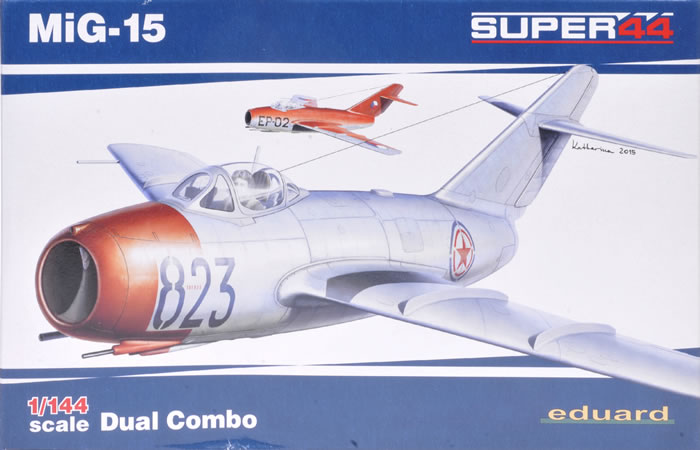
Eduard "Super 44", 1/144 scale
S
u m m a r y |
| Catalogue Number: |
Eduard Kit No. 4443 – MiG-15 (Dual Combo) |
| Scale: |
1/144 |
| Contents and Media: |
43 grey and one clear plastic parts per kit, with two kits supplied; a pre-cut paint mask for both kits; and decals for six subjects |
| Price: |
Available online from these stockists:
Click for currency conversion. |
| Review Type: |
FirstLook |
| Advantages: |
Great quality and moulding finesse; and the paint mask is a nice bonus |
| Disadvantages: |
None noted. |
| Conclusion: |
Eduard’s MiG-15 kits are a testament to just how refined 1/144 scale kits can be, and probably better the benchmark set by Sweet in this scale. Whilst the limits of injection moulding inevitably mean that some details will be over-scale, Eduard has managed to convey such a high degree of finesse that the eye is deceived where a micrometer would reveal this fact.
The only thing I did wonder about was why Eduard did not pair a MiG15 with a MiG-15bis in this dual combo, rather than two identical airframes. This does not in any way detract from the quality of the package however.
I cannot recommend this pair of miniature Fagots highly enough. |
Reviewed by Mark Davies

Eduard’s 1/144 MiG-15 Dual Combo is available online from Squadron.com
The Mikoyan-Gurevich MiG-15 (Fagot) surprised Western forces upon its service debut, and outclassed the Western fighters it opposed in the Korean War until the United Nation fielded North American F-86 Sabres to counter it. Both designs were the amongst the first widely deployed swept-wing fighter designs, and both would achieve well-deserved iconic status.
The MiG-15 exploited captured German aerodynamic research and, just as importantly, a license-built British Rolls-Royce Nene jet. The latter came about as a result of late-1940’s British government lunacy to share technology in accordance with a wartime offer; despite the onset of the cold-war. Much of the credit is of course also due to the MiG design Bureau, as far more was involved than simply cobbling together other nations’ ideas.
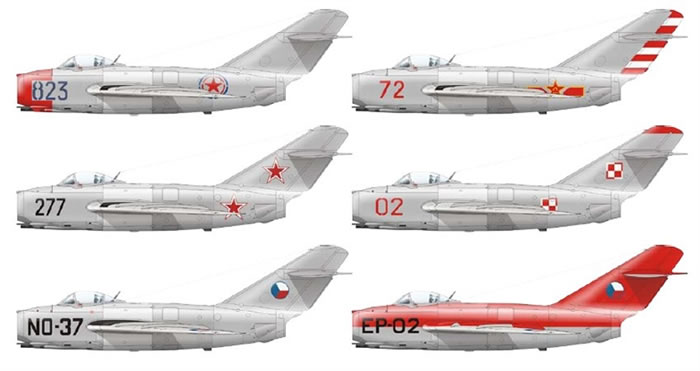
The MiG-15 effectively founded a dynasty of jet-fighters, and one of the most widely produced aircraft ever; with around 18,000 built when licensed production outside of the Soviet Union is included. Without doubt, it is one of the most widely used post-WW2 fighters, and introduced jet-powered warplanes to a multitude of air forces. Several still fly today in private hands as Warbirds, and perhaps there are still be some two-seat MiG-15UTI trainer versions in military service somewhere.
Check out Wikepedia here for more insight into the MIG-15’s history, development and service.
Previous 1/144 MiG-15 Kits
I do not have any expertise in 1/144 scale, but I am aware of two previous MiG-15 kits released in this scale by Attack Hobby Kits and Oz Mods. I have a passing familiarity with both brands, but have read any reviews about their MiG-15 kits. Eduard released their kit last year, and I would not be surprised to find that it is the MiG-15 to date in 1/144 scale.
The Contents
The parts come in a side-opening box with attractive artwork on the front and colour profiles on the rear. The airframe sprues are enclosed in a resealable cellophane bag, whilst the two clear canopy parts each come in their own resealable polythene bag. The decals and paint-mask are enclosed within the same resealable cellophane bag as the instructions.
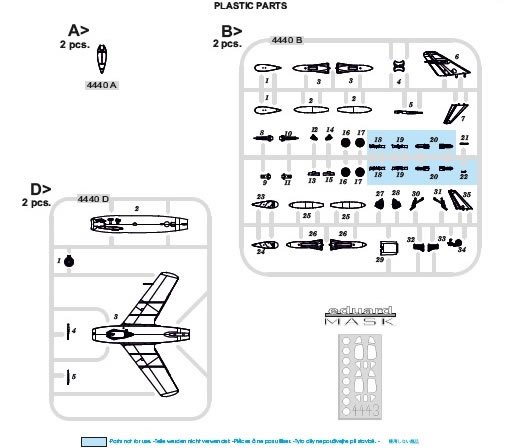
The instructions are a glossy colour printed booklet of the same quality and style as those found in Eduard’s Profipack editions. They include a parts map and have very clear and easy to follow drawings. English is used throughout, although there is a Czech edition for Eduard’s domestic market. Paint colours are cross-referenced to Gunze’s Aqueous and Mr. Color paint ranges (which Eduard stocks and sells on-line), and detail colour call-outs are provided throughout. A copy of the instructions can be down-loaded or opened as a PDF by clicking here.
The Kits
As they are identical, I shall use the singular “kit” when describing the pair of kits.
The kit is straightforward and well engineered, with a slightly unconventional parts breakdown; in that the fuselage is split horizontally with wings moulded in place with the top half. Parts are crisply moulded with delicate recessed surface detail, and include some very delicate items.
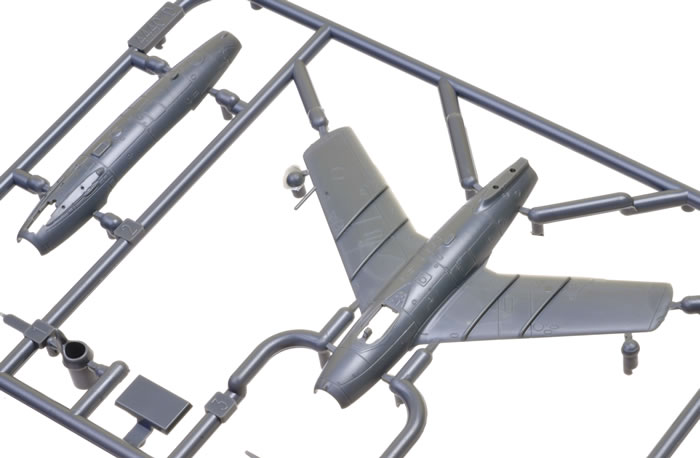
The cockpit is well detailed for the scale, and includes a decal for the instrument panel. Not a lot will be visible however, although the canopy is about as thin as is practicable nonetheless.
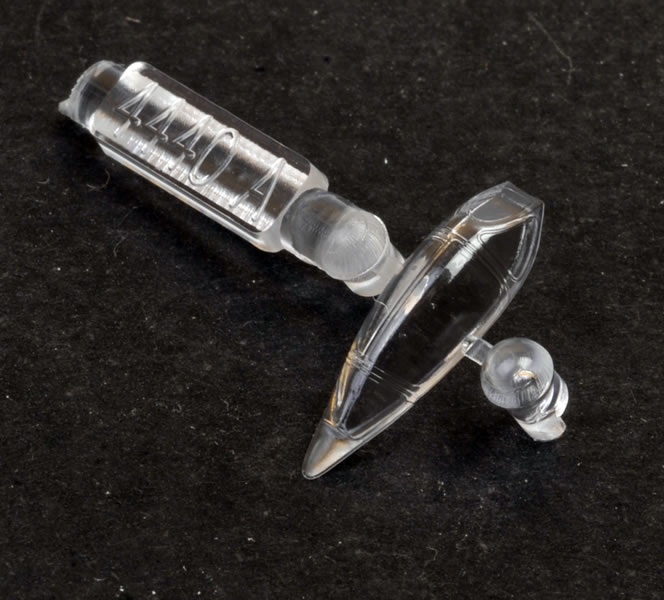
The air-intake splitter fits to the front of the cockpit tub and provides the nose-wheel bay. The whole sub-assembly fits within the fuselage halves.
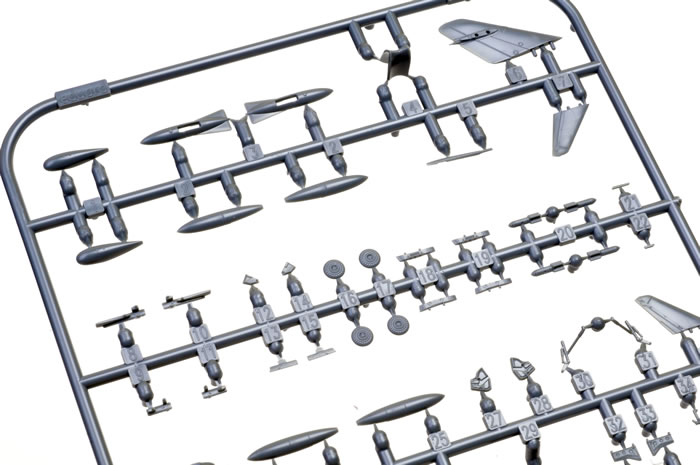
The jet-pipe is moulded integrally with the “pen-nib’ rear fuselage, and inserts into the two main fuselage halves. One advantage of the horizontal fuselage split is that the large amount of ventral and dorsal panel detail will not be affected by seam sanding. What panel detail there is on the fuselage sides should be easier in comparison to restore if necessary; although care around the outlines of the airbrakes will be needed. The 23mm cannon are moulded as very delicate separate parts, and these fit to the forward fuselage underside. The vertical and horizontal stabilizers are a straightforward fit, and like the wings, have commendably thin trailing edges for the scale.
The main wheel wells are boxed in and feature moulded detail on the inside of the wing. The main legs are incredibly fine, and will need to be removed from their sprue with considerable care. Suffice to say they are very nicely done; cunningly combining the main leg, damper arm, and brace as one part. The wheels and main doors are also nicely detailed (there is even a choice of wheel types), making for one of the most realistic fighter undercarriages I can recall seeing in this scale. The single-piece nose-wheel leg and wheel are equally good.

Unlike with their 1/72 MiG-15 kits, Eduard does not mention any need for ballast to prevent tail-sitting. I am inclined to caution for the careful use of ballast with this kit because the undercarriage legs are so dainty; I do not think that they will support too much extra weight. I read one build review that found a little weight placed inside the top of the intake splitter was sufficient.
All that remains to mention is the antenna mast that fits beside the right-rear of the canopy, and a choice of drop tanks, these being of the slipper-style mounted flush with the wing, and the conventional type that fits to a stores pylon.
From the little I have read about this kit, it would seem that it is trouble-free to assemble.
Markings
The decals look to be of superb quality, and the kit has six colour scheme options:
-
c/n 108023, 176th IAP, North Korean AF, Antung Air Base, Korea, April 1951.
-
EP-02, 1st Fighter Division, Czechoslovak AF, Ruzyne Airport, September 1955.
-
29th GIAP, Dachang Air Base, Chinese AF, Shanghai, China, spring - summer 1950.
-
NO-37, 2nd Squadron, 5th Fighter Regiment, Czechoslovak AF, Pizen-Line Air Base, Late-March 1953.
-
c/n 120077, Soviet AF, flown by Major Alexei A. Mikoyan, the Deputy CO of 274th IAP, Kubinka Air Base, early 1950’s.
-
1st PLM, Polish AF, Warsaw - Babice Air Base, 1951.
The quality of the decal sheet appears to be excellent, and includes wing-walk and rudder stripe markings where appropriate.
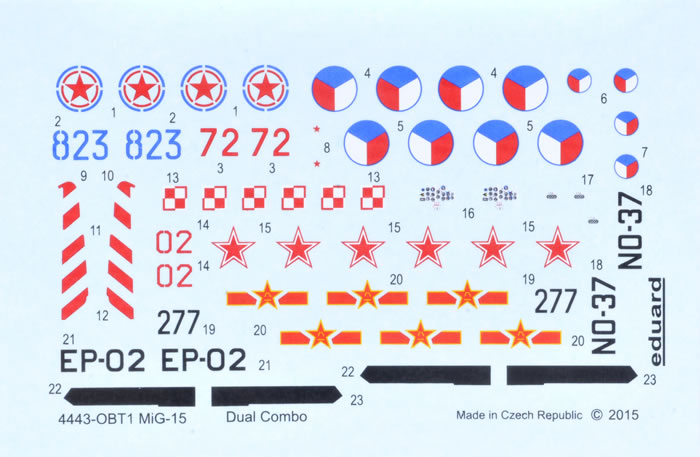
A nice touch to aid finishing is the pre-cut canopy and wheel mask (sufficient for both kits), which must make life easier when working with this small scale.
Eduard’s MiG-15 kits are a testament to just how refined 1/144 scale kits can be, and probably better the benchmark set by Sweet in this scale. Whilst the limits of injection moulding inevitably mean that some details will be over-scale, Eduard has managed to convey such a high degree of finesse that the eye is deceived where a micrometer would reveal this fact.
The only thing I did wonder about was why Eduard did not pair a MiG15 with a MiG-15bis in this dual combo, rather than two identical airframes. This does not in any way detract from the quality of the package however.
I cannot recommend this pair of miniature Fagots highly enough.
Thanks to Eduard for the sample
Review Text Copyright © 2015 by Mark Davies
Page Created 5 October, 2015
Last updated
5 October, 2015
Back to HyperScale Main Page
Back to Reviews Page |
